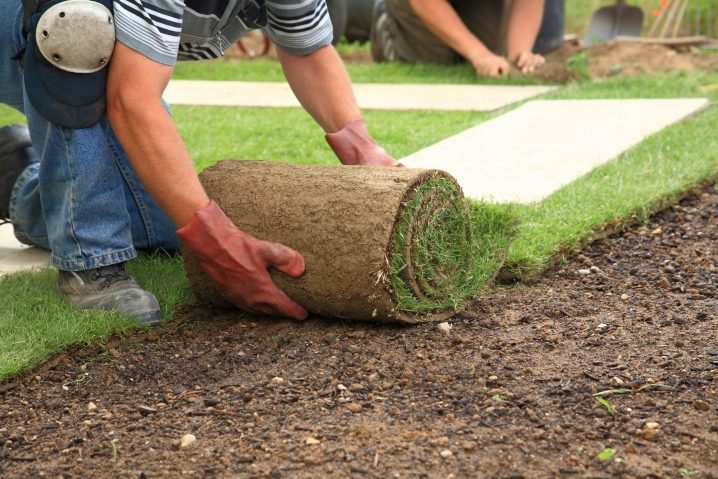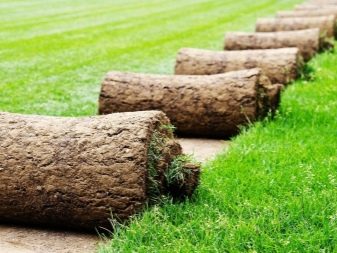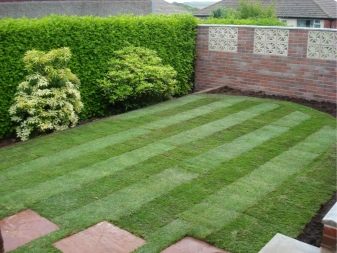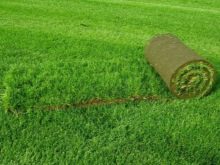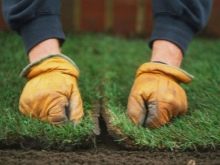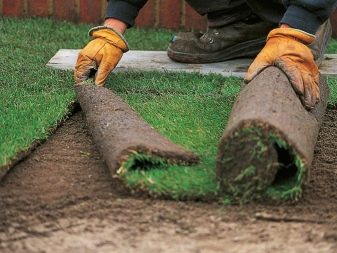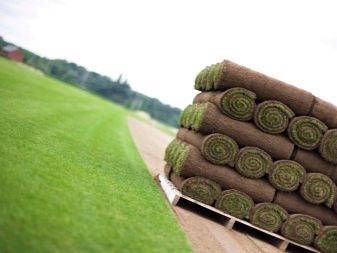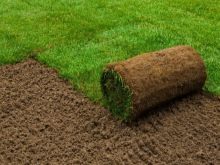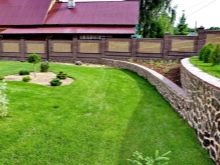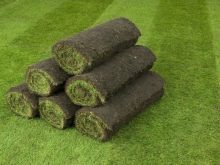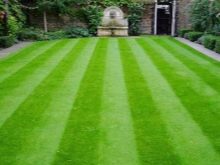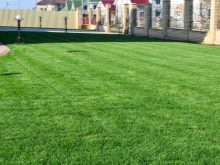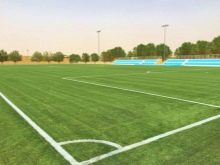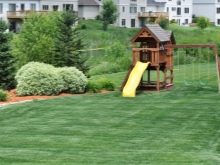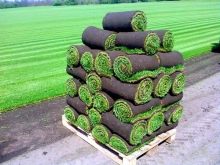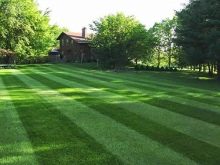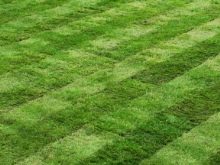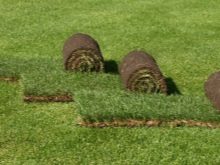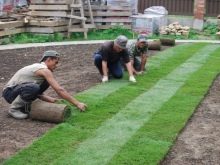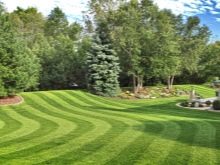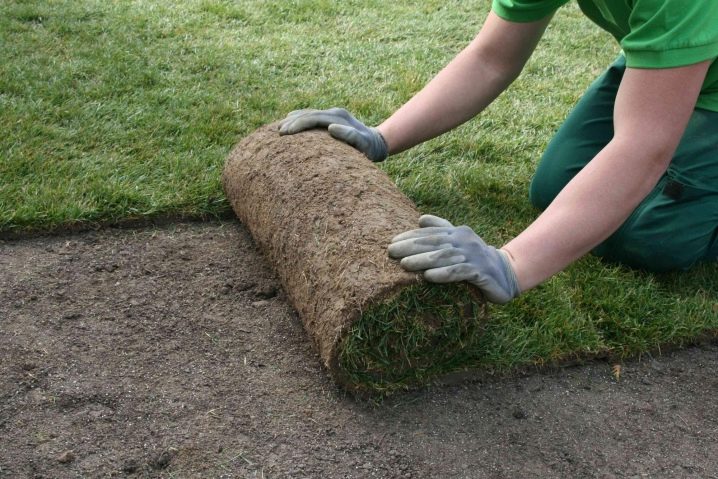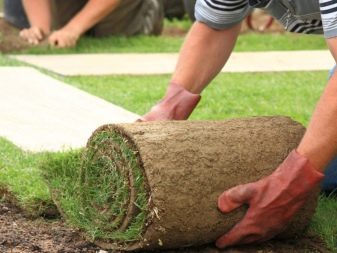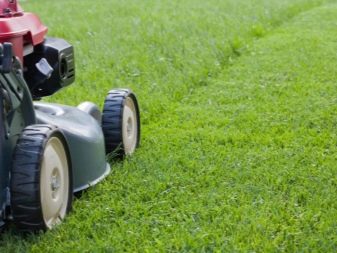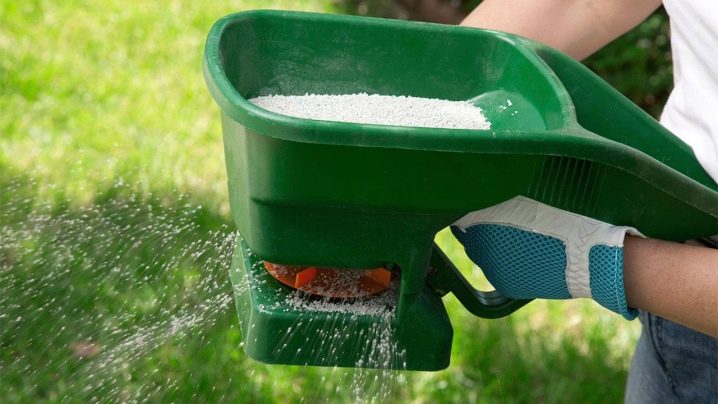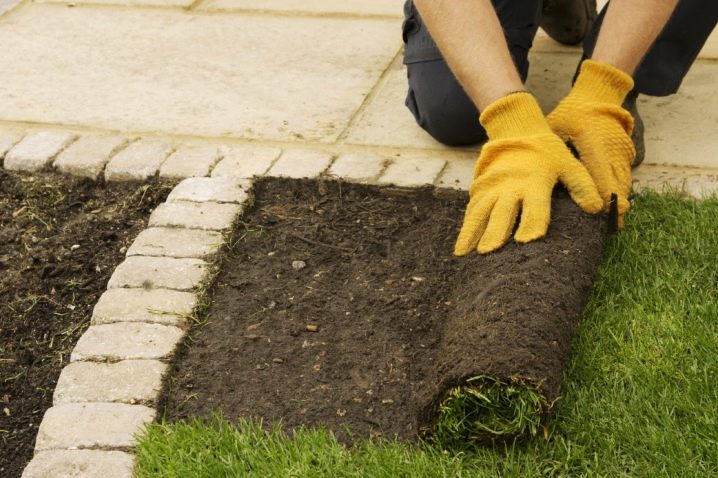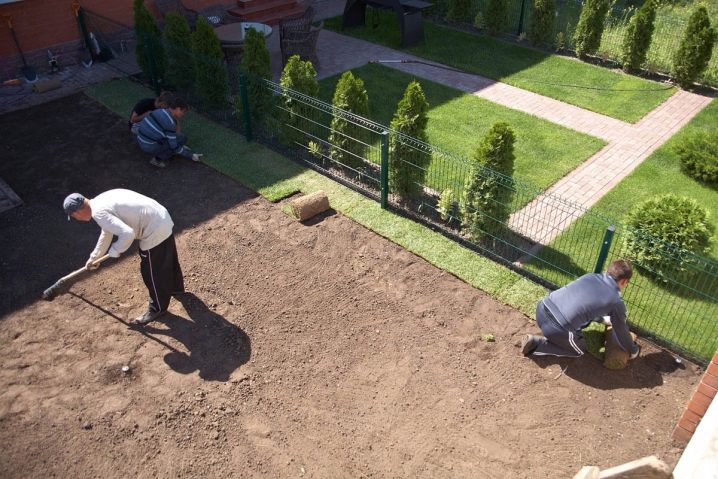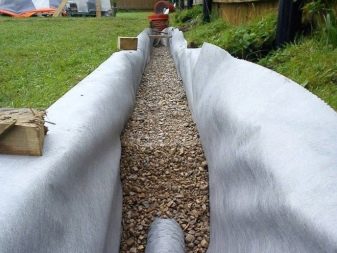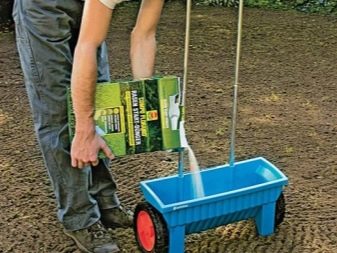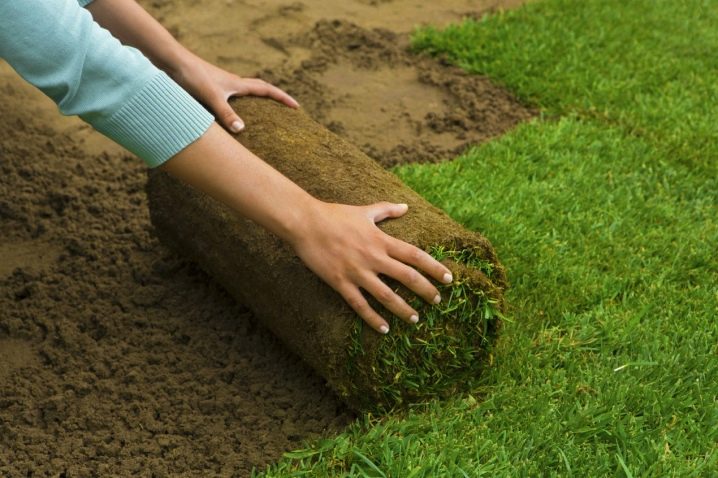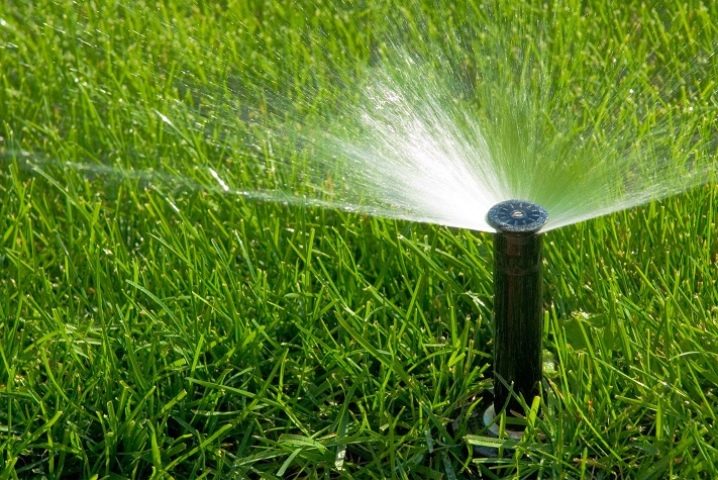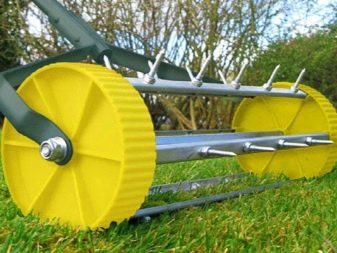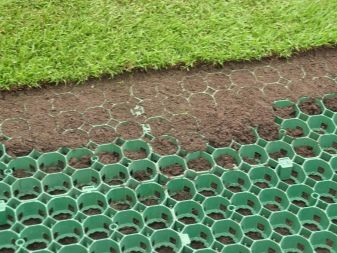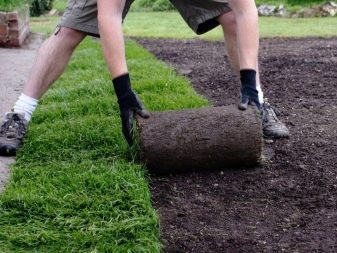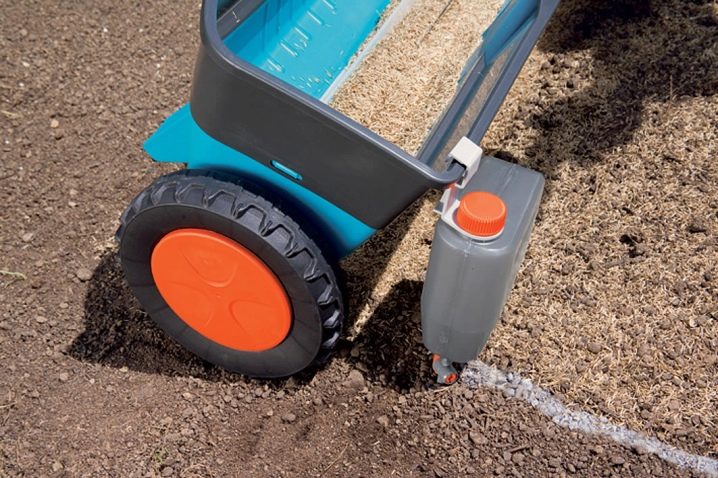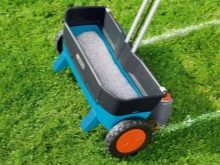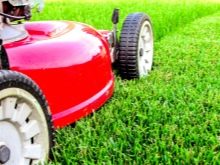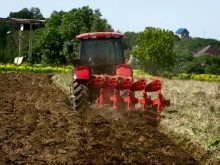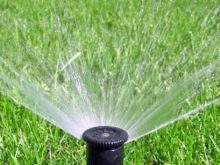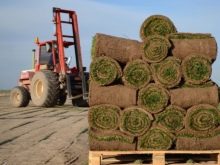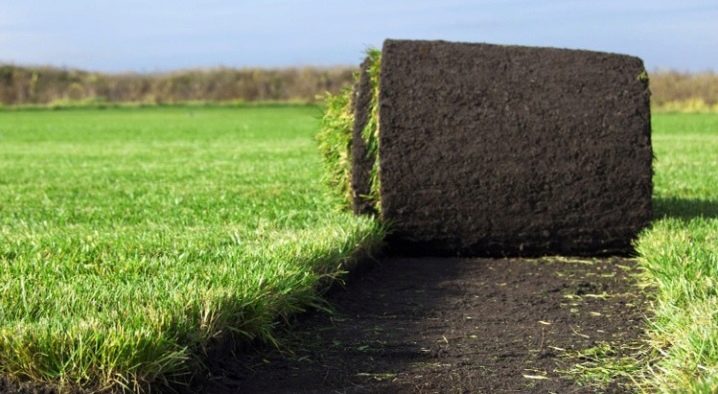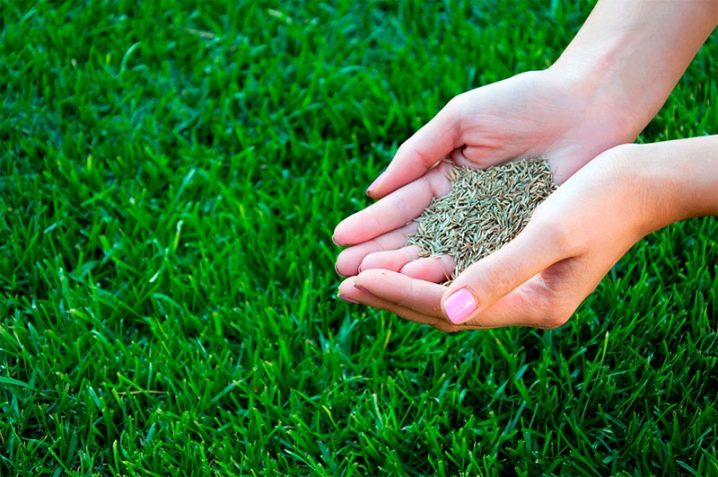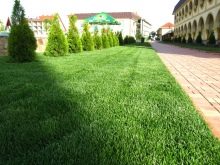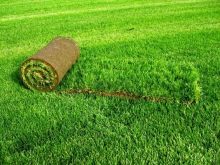Rolled lawn: laying technology
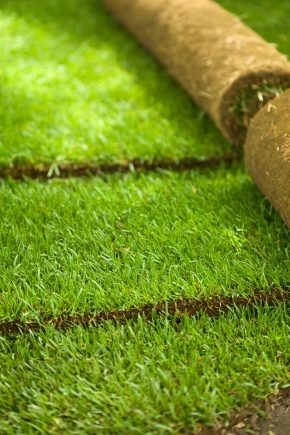
The arrangement of the local area with well-groomed lawns has not gone out of fashion for many centuries. However, few know that growing a lawn from scratch is a long and painstaking process. First you need to choose a suitable mixture of seeds, depending on the destination and area. Then carefully prepare the soil plot.
Sow evenly (approximately 50 g per 1 m2) and care for 1-1.5 years before the lawn acquires its attractive appearance. This is if you approach the issue classically. But fortunately for impatient people, lawn cover can be purchased off-the-shelf, and in a month they can have picnics on green grass.
Features and device
The finished lawn is a layer of sod with an average area of 0.8 m2. In contrast to the classical, it is grown in special nurseries for a half to three years. This period is sufficient for the formation of a firmly interwoven root system that will withstand cutting and transplanting. Most often, the finished lawn can be found in rolls. This is the most convenient method of transportation, which also allows you to retain moisture of the roots.
The sizes of a rolled lawn depend on its appointment. For example, for giving, parks use rolls of standard size 48 cm wide and 1-2 m long. However, for areas with a large area, such as stadiums, sports grounds, layers up to 1 m wide and up to 15 m long can be ordered. The cut thickness in both Cases range from 2 to 4 cm.
The advantages of a turf are obvious:
- uniform, thick grass cover on the site in a month;
- unpretentiousness in leaving and resistance to temperature changes;
- tightly intertwined root system inhibits weed growth;
- Cover is easy to repair if damaged. It is enough to cut off the deformed area and replace it with a whole.
The main disadvantage is the need to deliver and cover the place of the future habitat as soon as possible from the moment of cutting. Delay increases the likelihood of uneven rooting or death. If the area is too large and it is impossible to finish laying on the same day, the rolls should be unrolled and watered abundantly.
There are several varieties of turf:
- Parterny lawn - the most whimsical view, which draw parade areas (main alleys, the area in front of the house). It has a smooth velvety surface due to narrow-leaved and undersized cereals. On such a coating is not allowed heterogeneity of color and tartiness. One of the most important stages of its installation is the preparation of the soil (cultivation, destruction of weeds). Parternaya coating requires regular feeding and cutting, daily but moderate watering.
- Sports lawn designed for increased loads. For its creation are used varieties that are most resistant to damage and trampling.
- Universal lawn. This type can be found in parks, gardens and squares. Its name speaks for itself.It is durable, beautiful, resistant to various temperatures and damage, unpretentious in the care.
- Shadow lawn. Features included in shade-tolerant grasses allow you to lay it in the shaded parts of gardens and parks. He maintains the increased humidity and does not need a frequent hairstyle.
How to choose?
It is necessary to approach the choice of a lawn covering with special care as the appearance of the settled territory depends on it. To insure against a failed purchase will help knowledge of some nuances:
- The presence of technical documents, which reflect the quality control checks, as well as the location of the nursery.
- Much of the lawn will tell a visual inspection of the cut. Thickness uniform over the entire length, dense interlacing of the roots without gaps, absence of gaps and other deformations with shaking is a sign of a quality product. The presence of young roots will be a big plus (different in white). This means that the grass will be used more quickly after transplantation.
- Appearance is also important. It is necessary to avoid layers with a large number of weeds, with the presence of yellowed areas or bald spots.The coating should have a uniform color, from dark green to emerald green, with a density of 100 shoots per 10 cm2. Another indicator is grass height. If it is less than 3 cm, the manufacturer probably tried to hide the flaws.
How much will it take?
Calculating the number of rolls does not require complex mathematical formulas. It is enough to divide the area of the site by the area of one roll. For example, the bed area of standard dimensions is 0.4x2 m = 0.8 m2. Having a plot of, say, 50 m2, we get: 50 / 0.8 = 62.5 rolls.
But, like any other material, the lawn is better to buy with a margin. Depending on the geometry of the site, to the actual area will need to throw from 5 to 10-15%.
Well, if you need the most accurate calculation for a lawn of a complex configuration, you can draw a detailed plot of the plot to scale. Then, also using scaling, place the rectangles of the coverage in the diagram. This picture clearly shows the required number of rolls for a particular territory.
It is believed that the turf can be laid at any time of the year, excluding the winter, of course. Spring is a good time to start work. Under favorable conditions, the germination of roots will take about three weeks, after which you can hold the first haircut.
But there is a snag - it is difficult to acquire material before May. After the winter, the manufacturer needs a month and a half to bring the lawn into a presentation. During this time, last year's dry grass is picked, fertilizers are applied and it is expected that fresh shoots will sprout.
In the summer, planting a turf will not be a problem either, if you follow the rules. It is advisable to start as early as possible, until the summer heat has come into its own. Until the grass is applied, the water will evaporate faster, so the freshly laid lawn will require daily or even twice watering. After a couple of weeks, it will be possible to reduce the watering to once every four to five days.
The most comfortable time for work is early autumn. The heat has already subsided, the soil is warm and rather wet. At this time, the grass is well received and continues to grow until the temperature drops to 5 degrees. It is not necessary to mow the lawn in the fall, the shoots should be high enough for the lawn to safely survive the first winter. In the spring of old cover will need to be carefully cleaned to clear the path for young shoots.
Land preparation
Having decided to lay the lawn in front of the house in rolls, do not rush to the store.To begin with, it is necessary to carefully prepare a place for planting grass and it is very important to do this before purchase, since long storage is detrimental to the material:
- Firstly, plot cleared of garbage, perennial weeds, stones, stumps and bushes. Particular attention should be paid to rhizome plants (dandelion, wheat grass, plantain). They are very tenacious and able to grow through the turf of the lawn, so it will be difficult to get rid of them in the future. Herbicides of continuous action will help to solve this problem.
- Ready lawn does not like excessive moisture, so if groundwater is high or clay soil is required make water drainage. To do this, cut the top layer with a thickness of about 30 cm. A drainage layer of gravel and sand (≈ 10 cm each) is poured into the resulting excavation. Then fall asleep previously removed soil thickness of at least 10 cm.
If necessary, sand and peat are added to it, as cereals like a lighter soil. And, on the contrary, if the earth is too loose, it is “weighed down” with black soil or humus. The following combination will be most suitable for a turf lawn: 50% of black soil and 25% of peat and sand each.Everything is carefully leveled, in places of obvious depressions or slopes, the soil is poured (it is convenient to orient by the level or the tensioned string).
- Approximately a week before laying the finished lawn introduce special fertilizer, lightly mixed and well tamped with a roller. The density of the soil should be such that the person walking does not leave traces. This will help to avoid sinking the lawn. At the same stage, you should take care to install the irrigation system.
How to lay?
The technology of laying turf is so simple that you can do all the work with your own hands without the involvement of specialists. However, it is difficult to arrange too much territory on one’s own in one day, so a couple of helpers will come in handy:
- Purchased rolls are best folded as close as possible to the section; frequent transfers can damage the cover and the roots.
- Starting work is best from the edge. The first roll is important to put as smooth as possible, since it will serve as a guide for the rest. Bending and twisting of the material is not allowed. If there is a plot with a complex geometry or an obstacle in the form of a flower bed or path, the roll continues to roll straight, and the excess is cut (we counted the number of bays with a margin).
- Each next row is laid according to the brickwork principle, that is, shifted by half a roll. This will allow the coating to be applied more evenly. Overlap or gaps - this is a gross violation of technology. The seams should lie butt-to-butt, the maximum allowable discrepancy is 1.5 cm. The seams are covered with peat and soil with grass.
- If you get a lot of large trim, it is better to arrange them closer to the center, the edges of the lawn is more difficult to accept, so here it is better to use solid stripes.
- The irregularities found in the course of the work are cut, and the pits fall asleep. For each freshly laid row, you should additionally go through the roller to get rid of air cavities that make it difficult for plants to take root.
- You can’t walk straight through the new cover. To do this, they place boards on it, which will additionally compact the grass and prevent the paving of the still fragile lawn with their feet.
- The final stage of installation is abundant watering. The sod and bottom soil should be well moistened. Approximately one square meter will leave one bucket of water.
- If you are not engaged in laying yourself, there is no time or desire, you can contact the manufacturer.Often, along with the cultivation of the lawn, they are engaged in his device at the customer. The package of services includes all preliminary works, installation of irrigation systems and their maintenance.
Care
In the first year after laying the lawn requires more attention. In the first month it is better to refrain from walking on it. Regular daily watering is simply necessary, as the roots are not strong enough to retain water. And on hot days, you'll have to grab the hose twice.
Undoubtedly, care will facilitate the automatic irrigation system. It allows you to simultaneously and evenly cover the entire area. However, you need to install it at the preparation stage.
After 2-3 weeks, watering can be reduced to once a week. At the same time, you can walk along the tips of the shoots for the first time. In the future, the height is chosen as desired. The ideal height is 4-5 cm.
Starting from the second year, the haircut is carried out regularly: from mid-spring to October. During the rainy season, the grass is cut lower, in the dry months, respectively, higher. Mowed grass must be cleaned, for large areas you can buy special vacuum cleaners.
At first, you should monitor the weeds.They are quite tenacious, so that, despite all the tricks, can make their way to the site. Later, when the root system is strengthened, the problem will gradually disappear ..
For the well-being of the lawn, it is necessary to periodically feed it with fertilizers and conduct aeration. The surface is periodically pierced with a special tool to ensure the access of oxygen deep into the ground. Lovers of fresh air can combine business with pleasure with aeration shoes.
Production
Farms engaged in the cultivation of lawn coverings are called “lawn nurseries”. Manufacturers use two methods of cultivation: on a synthetic mesh and without it, when dense sod is formed by interweaving roots. The grid allows in a shorter time to get a sod with a strong structure. It is also used for crops with a weak root system.
In the production of rolled lawn can be divided into two stages: the preparation of the field and cultivation.
- The goal of the preparatory stage is to create a soil conducive to cultivated plants.. This is facilitated by the work of plowing and disking the upper layer, which not only saturate the earth with oxygen, but also destroy pests and weeds.The issue of weeds is very important for lawn covering, as they can prevent the formation of the root system and the uniform growth of plants. Therefore, the soil is additionally treated with herbicides and for about two years you can forget about the problem. This is enough to strengthen the root system of lawn plants and independently fight weeds.
At the same stage, the field is divided into sections and the placement of pipes for the irrigation system is designed. If you plan to make a lawn on a grid basis, then the size of the plots should be a multiple of the grid size.
- When all the preliminary work is completed, you can start growing. To begin with, the field is sown using precision seed drills. Their peculiarity is that the seeds are planted at a certain depth with uniform density. It is important to preserve the fertile soil layer when cutting the lawn.
Further, the behavior of the future lawn depends on the care of him. For several years, the coating is subjected to regular watering, feeding and shearing. The land area involves the use of a stationary automatic irrigation system, which is calculated individually for each farm.For dressing, fertigation is increasingly used, when fertilizers in liquid form are applied simultaneously with irrigation. Grooming is important for better root development and the formation of a dense herbal layer.
When the lawn has reached the desired state, it is prepared for sale. Cut the strip from which make rolls and transported to the place of sale.
Required materials and tools
For the successful development of this kind of business, land plots of considerable size (preferably horizontal) and special equipment are needed. Of the equipment will be useful: machines for earthwork (plows, harrows, cultivators, seeders), for grass care, for cutting, sprayers for chemicals and fertilizers, irrigation system, pumping station, cargo transport.
The main component of success in the production of turf is the correct selection of herbs. For luxury lawns most often use no more than two types of crops. In the top is a coating of 100% meadow bluegrass. This is a perennial plant with a well-developed root system. It is valued for its uniform coat of rich emerald color, resistance to temperature extremes and damage.The only negative - a long formation (up to 3 years).
The most common mixture of varieties characterized by uniform texture and color. All plants in the mixture are selected in such a way as to balance the cons of each other. Most often, you can find a mixture of meadow grass, red fescue and ryegrass.
Fescue in general can be called a universal plant. She is unpretentious, she is not afraid of trampling, drought and frost. It grows even in poor soil, develops rapidly, compensating for the slow development of bluegrass, and thanks to the root system, it displaces weeds.
Ryegrass lives a maximum of three years, but grows quickly and in the first year it gives the lawn a good density. His task in grass mixtures is to provide the necessary density of grass cover, until the bluegrass with fescue comes into effect.
The following characteristics are inherent in herbal mixtures:
- uniformity of shoots;
- the formation of dense turf as soon as possible;
- resistance to weather and operating conditions;
- uniform color;
- resistance to diseases and pests.
How to lay a turf correctly, see the video below.
